
Here to serve the people of Montana and its livestock industry.
Animal Health Bureau
- Permits & Forms
- Brucellosis
- Brucella canis
- Feral Swine
- High Path Avian Influenza
- Johne's
- Rabies
- Trichomoniasis
- West Nile Virus
- National Poultry Improvement Program (NPIP)
- Pay for Permits Online
Helpful Links
Contact Information
Department of Livestock
Animal Health Bureau
PO Box 202001
Helena, MT 59620-2001
Email: livpermits@mt.gov
Brucella canis in Montana
Click the highlighted link below to go directly to that section.
- Guidance Documents
- Disease Summary
- Reportable Disease Information
- Epidemiological Information
- Guidance for Testing/Surveillance of Animals in Shelter/Rescue Channels
- Guidance for Testing/Surveillance of Dogs in Breeding Kennels
- Brucella canisTesting Options
- Laboratory Criteria for Diagnosis and Case Definitions
- Management Recommendations
- Human Health Risk
- Additional Resources
GUIDANCE DOCUMENTS
Surveillance Recommendations for Shelter/Rescue Dogs Flow Chart (PDF)
ELISA Test Interpretation for Veterinarians Flow Chart (PDF)
Guidance for owners of B. canis positive dog (PDF)
Prevention and Control Recommendations (PDF)
B. canis Pamphlet for Animal Owners (PDF, trifold version)
DISEASE SUMMARY
Brucella canis (B. canis), the bacteria that causes canine brucellosis, is one of several zoonotic Brucella species. The domestic dog is the only significant host of B. canis and dogs rarely become infected with other Brucella spp (i.e. Brucella abortus in cattle or wildlife). The disease is endemic in areas with large populations of stray, intact dogs.
This disease is mainly transmitted through reproduction and by nose/mouth contact with vaginal discharge or birthing fluids from an infected female. However, semen, urine, feces, blood, saliva, and nasal secretions can also contain the bacteria and are potential risks for transmission to people and other dogs. Furthermore, puppies can become infected from their mother during pregnancy.
Clinical signs in intact animals include abortion, infertility, and genital abnormalities (esp. orchitis, inflammation of the testicles). However, recent cases have involved spayed/neutered dogs who may present with more general signs such as lethargy, lymph node enlargement and lameness/back pain due to discospondylitis. Additionally, many dogs with B. canis infection show no clinical symptoms. Unfortunately, the infection may go unnoticed for years, especially in animals infected at birth.
Additional disease information on B. canis.
REPORTABLE DISEASE INFORMATION
B. canis is a zoonotic reportable disease in Montana per Administrative Rule 32.3.104. The department has quarantine authority; however, cases involving single animals or cases isolated to a private residence are not routinely quarantined. Owners of B. canis positive dogs should be given information regarding the risks of this disease and the recommended management: Guidance for Owners of B. canis Positive Dog.
Failure to comply to management recommendations and to disclose B. canis diagnosis will lead to a continued increase in positive cases, devasting disease in dogs, and potentially cases in humans.
EPIDEMIOLOGICAL INFORMATION
DOL has been tracking an increase in the number of overall testing and of reported B. canis positive cases, with several cases epidemiologically related based upon where animals originated. Areas with large populations of sexually intact animals, including reservations, are at a higher risk for B. canis infection. As a result, animal shelters/rescue organizations and individuals living in or around these areas are at a higher risk for homing infected animals.
We are beginning to see a broader distribution of cases throughout the state. Shelter/rescue groups have contributed greatly to MT surveillance and perform a significant amount of MT testing.
-
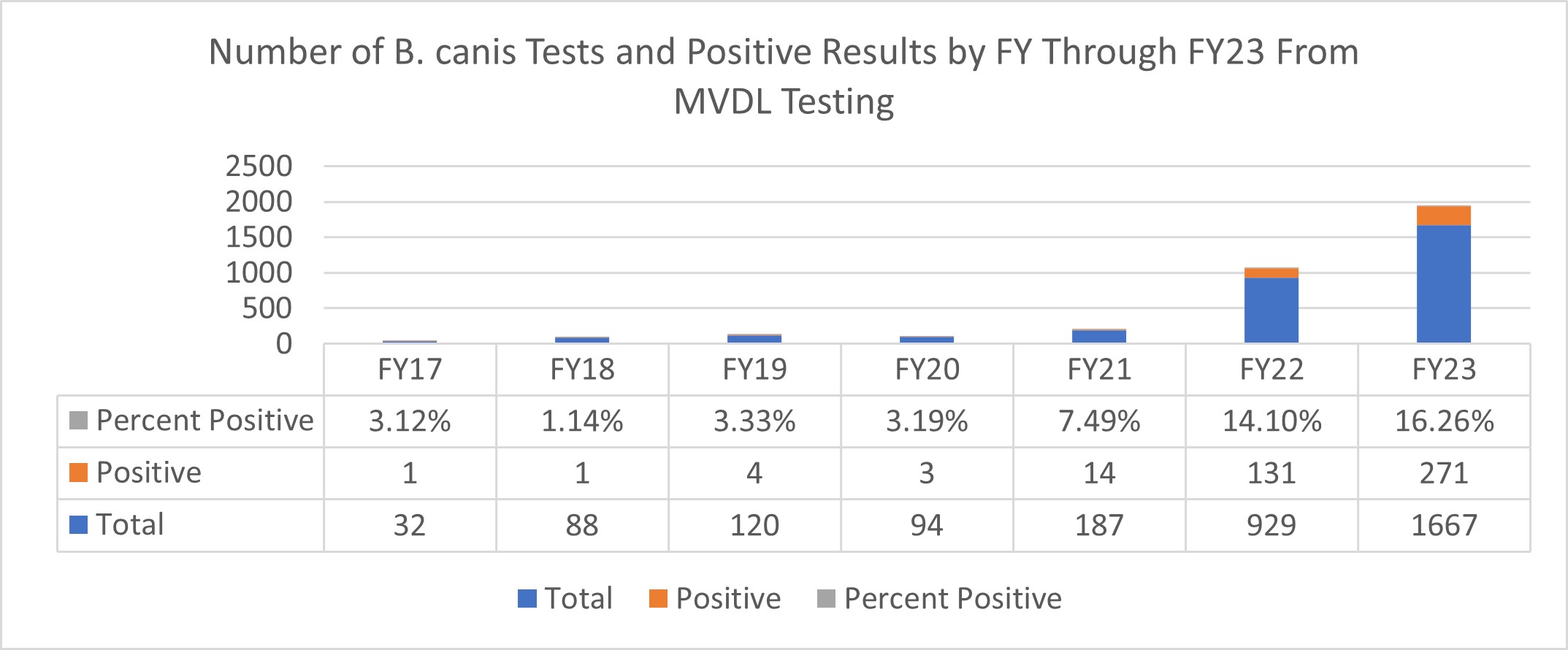
Fig. 1: Graph showing number of overall B. canis tests vs number of positive results from screening tests performed at MVDL per fiscal year. Last updated 7/1/2023.
-
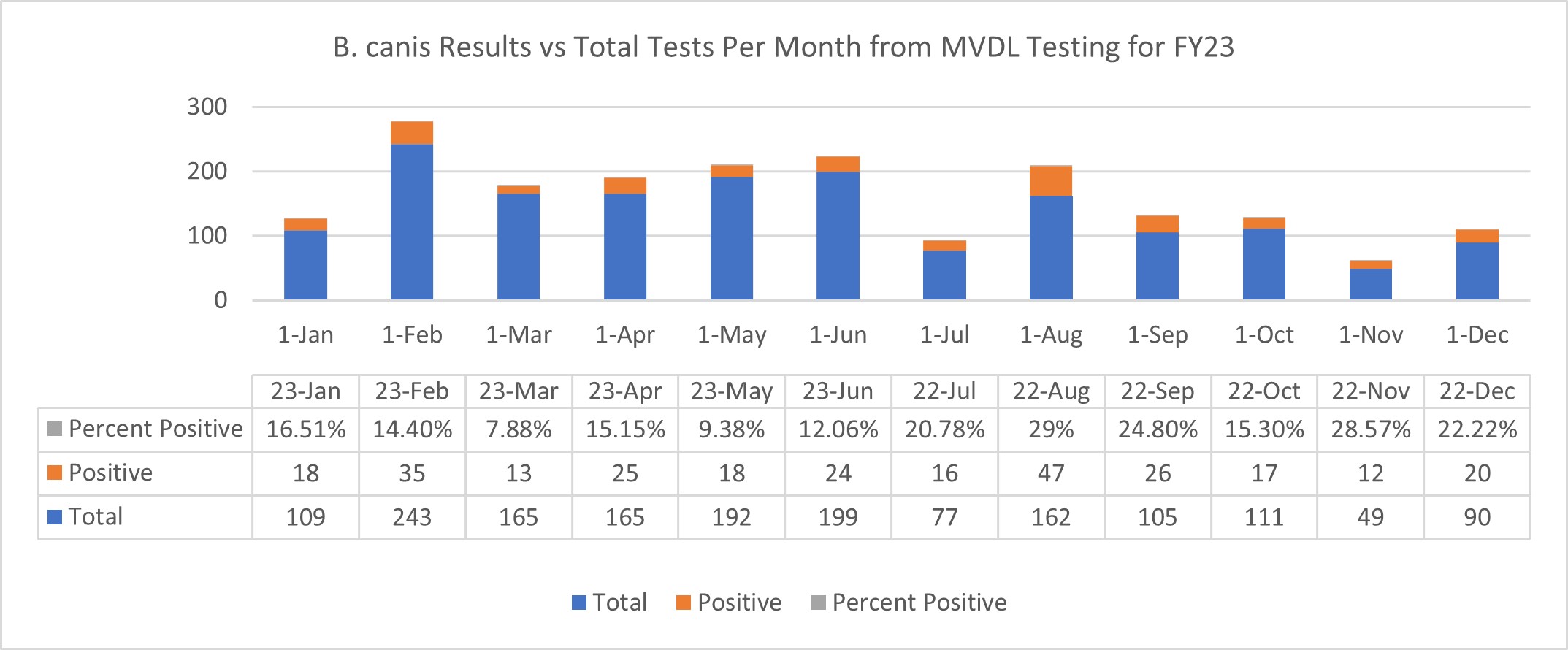
Fig. 2: B. canis Positive Results vs Total Tests Per Month from MVDL Testing in FY23 (7/1/2022-6/30/2023).
-
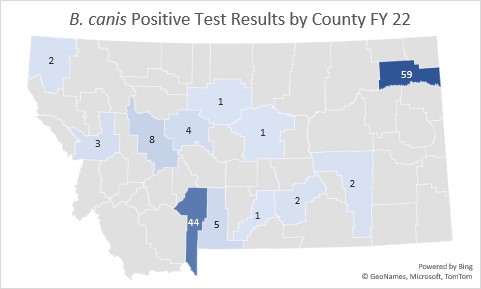
Fig. 3: Number of positive B. canis positive results on screening tests performed at MVDL by county for FY22 (7/1/2021-6/30/2022).
-
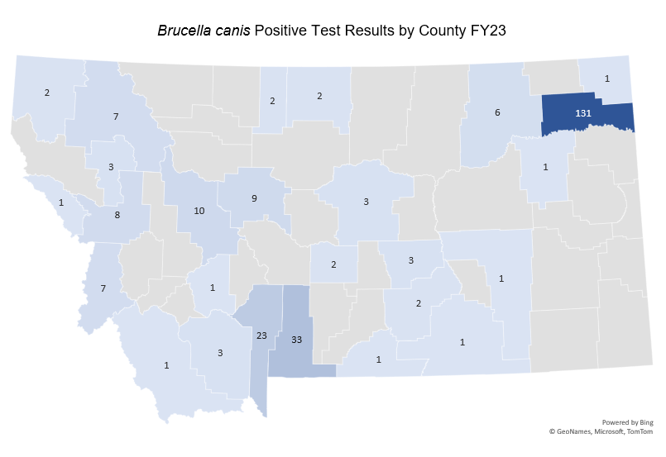
Fig. 4: Number of B. canis positive results on screening tests performed at MVDL by county for FY23 (7/1/2022-6/30/2023).
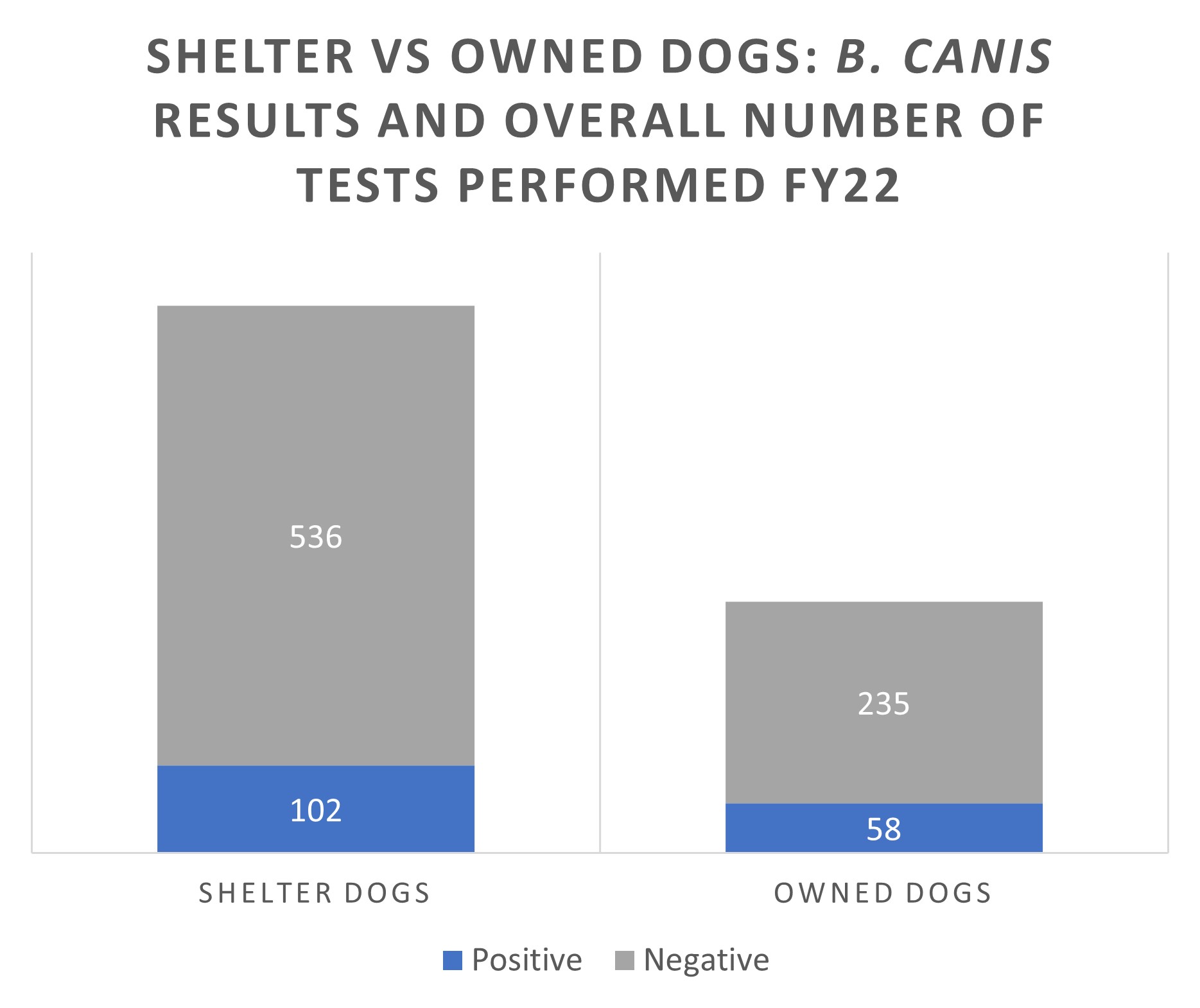
Fig. 5: DOL has asked for increased surveillance testing for B. canis for the past 2 years. In FY 22, 7/1/2021-6/30/2022, a large majority of overall testing was performed through rescue/shelter facilities. However, the Owned Dog category yielded a higher percentage of non-negative results, likely because this group represented more symptomatic dogs.
GUIDANCE FOR TESTING/SURVEILLANCE OF ANIMALS IN SHELTER/RESCUE CHANNELS
DOL would like veterinarians and animal caretakers who work with and live with dogs from high-risk populations to be aware of the potential disease risk. Through education and surveillance testing, our goal is to reduce the number of positive animals placed into homes, thereby reducing the risk to human health. We encourage animal shelters, animal rescue organizations and concerned animal owners to work with a local veterinarian when trying to evaluate risk for B. canis.
The DOL considers high-risk dogs and/or dogs that should be tested to be:
- An animal that originates from a population with a high number of intact, stray dogs.
- New intake at a shelter/rescue of a mature, intact animal if testing history is unavailable.
- Dogs with exposure to a known B. canis positive dog.
- Periparturient dogs that were not tested prior to breeding.
- Sexually intact dogs as part of a routine pre-breeding exam.
- Dogs with symptoms consistent with B. canis infection which cannot be explained by other disease.
The symptoms associated with B. canis include:
- Reproductive abnormalities: abortion, stillbirth, weak puppies that die soon after birth, infertility
- Genital abnormalities: orchitis, epididymitis, scrotal edema
- Discospondylitis
- Lymphadenitis
- Unexplained lameness or pain
- Uveitis
- Lethargy
- Anorexia
* Many patients with B. canis are asymptomatic
High-risk dogs and dogs presenting with clinical signs should be screened for B. canis. Because B. canis, like other Brucella species is difficult to diagnose, DOL has developed a flow chart to help guide screening programs (view the flow chart).
GUIDANCE FOR TESTING/SURVEILLANCE OF DOGS IN BREEDING KENNELS
Due to the increased concern for B. canis infection throughout the state, DOL recommends that breeding kennels perform screening tests of all dogs over 6 months of age at least once every year. If there are any reproductive abnormalities within the breeding group B. canis screening tests should be performed. If an intact male or female has left the kennel for any reason other than a veterinary visit, the dog should be tested 8 weeks after returning to the kennel.
If a positive result is obtained, that dog should be isolated and classified as a Brucella suspect. The suspect dog should have a recheck after 30-60 days using the same test and laboratory as the first test. If the recheck is still positive, then additional testing is recommended for confirmation of disease.
Additional information on best practices for prevention and control of B. canis in a breeding kennel.
Brucella canis TESTING OPTIONS
Brucella testing is a serial testing process. A serial testing process starts with a screening test followed by a confirmatory test of all non-negative samples. The purpose of a screening test is to detect ANY potential positive animal. This means there WILL BE nonspecific reactors, which require additional testing for definitive diagnosis. Serial testing improves diagnostic specificity and positive predictive value of a test process and asks the animal to “prove” it is affected by the condition being tested.
DOL recommends starting with the B. canis ELISA test that is offered through MVDL, which has few false negatives. A positive result on the B. canis ELISA test may indicate: a true infection, titers due to exposure (or from maternal antibodies if <6 months old), or cross-reaction to another pathogen. A negative result on the ELISA is considered a true negative unless the patient exhibits symptoms that are not explained by another disease. See the following table for additional testing information.
DIAGNOSTIC OPTIONS
| Test | Sample | Sensitivity Specificity | Turnaround time | Comments/Links |
|---|---|---|---|---|
|
B. ovis/canis ELISA performed at MVDL *Recommended screening test* |
Serum |
Sn = 70% Sp = 97% |
1-7 days |
|
| Indirect Fluroescent Antibody (IFA) performed at MVDL, IDEXX, Antech, and many others | Serum |
Positive Predictive Value = 99% |
1-3 business days |
|
| Multiplex performed at Cornell | Serum |
Sn = 95% |
1 business day for negative results |
Brucella Multiplex Testing for Dogs | Cornell University College of Veterinary Medicine
|
| Agar Gel Immunodiffusion (AGID) performed at Cornell | Serum |
Sn = 53% Sp = >99% |
Changes to Brucella canis Serology Testing | Cornell University College of Veterinary Medicine
|
|
|
Brucella Culture performed at NVSL |
Blood, urine, tissues, reproductive fluids | 5-14 days |
|
|
| PCR performed at Kansas State | Blood, reproductive fluids |
Sn = 80-100% Sp = 92-100% |
3-4 business days |
|
LABORATORY CRITERIA FOR DIAGNOSIS and CASE DEFINITIONS
Diagnostic Criteria
| SUSPECT | PROBABLE | CONFIRMED |
|
Screening test with the following criteria:
|
Screening test with the following criteria:
|
Definitive laboratory test positive with/without symptoms:
|
|
Management: Isolate and retest after 30-60 days. |
Management: Isolate and retest after 30-60 days; Euthanasia is an acceptable option. |
Management: Euthanasia strongly recommended. Alternate option: lifelong quarantine, spay/neuter, and adhere to Prevention and Control Guidelines. |
MANAGEMENT RECOMMENDATIONS
Unfortunately, the primary management recommendation for positive B. canis cases is euthanasia. B. canis is not curable, not a benign disease in the dog, and is a zoonotic risk. Sterilization (if intact), lifelong antibiotic treatment, isolation in the home, and routine testing are offered as a second management option though treating B. canis cases is challenging, can be expensive, and is not be considered curative. The bacterium can sequester in areas, such as the prostate, making it difficult for antibiotics to penetrate and eliminate all the organism. Recrudescence may be observed when administration of antibiotics is discontinued resulting in long-term treatment with combinations of medically important antibiotics. Ultimately, many cases result in euthanasia of the animal due to the secondary clinical signs that cannot be effectively treated.
An owner that chooses not to euthanize his/her B. canis positive dog has the responsibility to limit the spread of this disease: Prevention and Control Guidance.
DOL currently recommends that shelter/rescue dogs that test positive for B. canis (even if test performed is considered a screening test) are euthanized. An alternative option is to hold, isolate, and retest after 30-60 days. Dogs presenting to a shelter/rescue with any risk factors should be tested prior to adoption and, when possible, immediately upon intake and isolated until results obtained. B. canis infected dogs should not be placed in foster care nor adopted. Should a B. canis positive dog be placed in a home, the adoptees must sign a disease disclosure document showing their understanding of the infection and potential risks to family members. Similarly, veterinarians have the responsibility to discuss the risks with owned dogs that test positive and provide disclosure paperwork.
HUMAN HEALTH RISK
The zoonotic risk of B. canis is not fully understood and human cases are likely under-diagnosed. While human infections appear uncommon, people who have a compromised immune system, young children, pregnant women, or persons with artificial heart valves are at risk of severe disease if they acquire the infection. Refer to the MT Department of Public Health and Human Services (DPHHS) document Canine Brucellosis-Q and A for Dog Owners for more information. Please contact your local public health office or physician with questions about the zoonotic risk.
People who are in contact with breeding dogs, newborn puppies, or aborted fetuses should always practice good hygiene. In general, all animal caretakers should wear gloves when handling bodily fluids from an animal and should regularly wash hands with soap and water. More information on disease prevention can be found in the Compendium of Veterinary Standard Precautions for Zoonotic Disease Prevention in Veterinary Personnel.
ADDITIONAL RESOURCES
Disease Information (PDF)Human Health Risk (PDF)
Montana Veterinary Medical Association Resolution 2022 (PDF)
USDA Best Practices for Brucella Canis in Breeding Facilities (PDF)